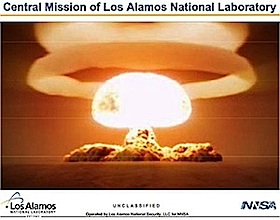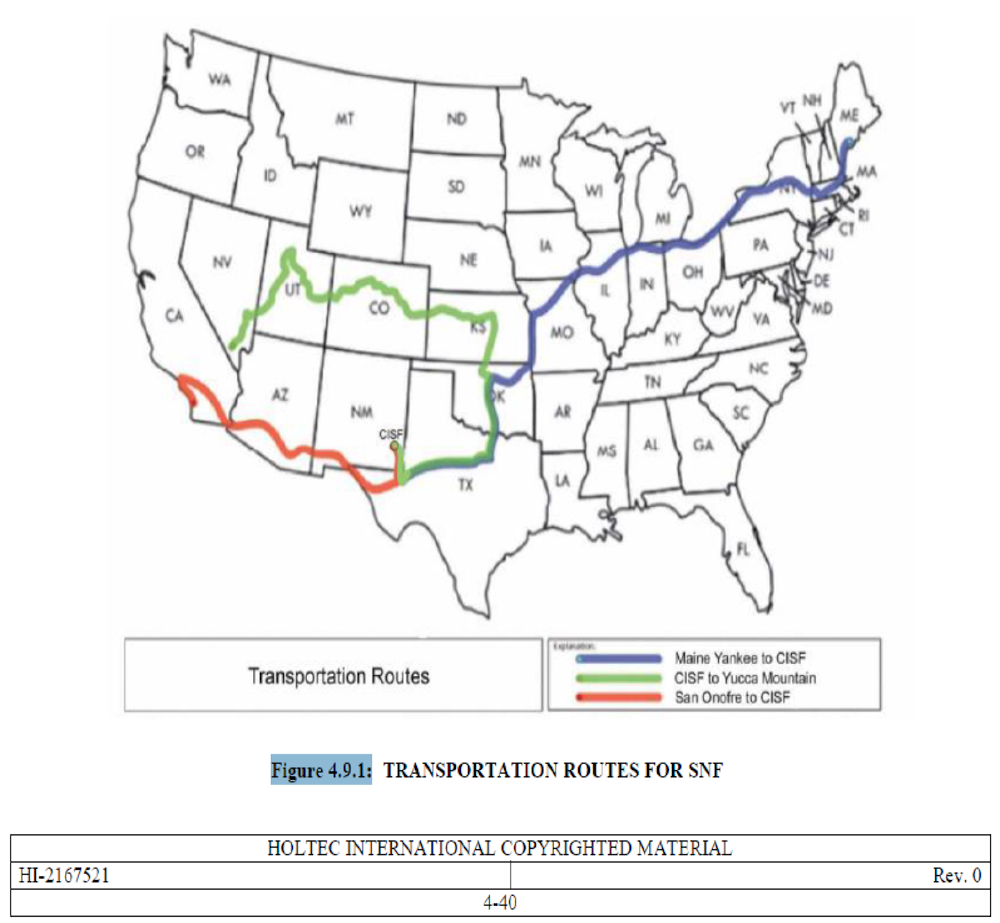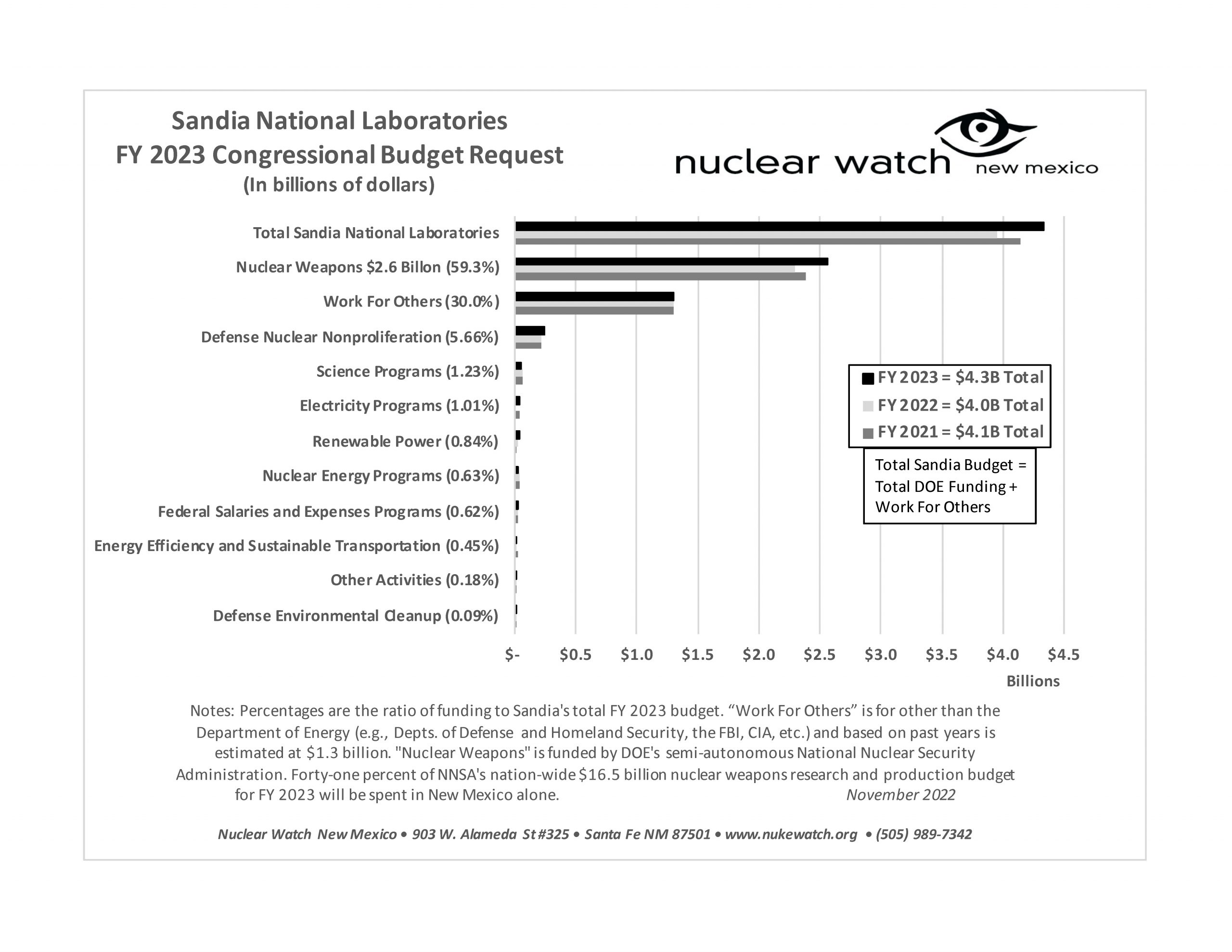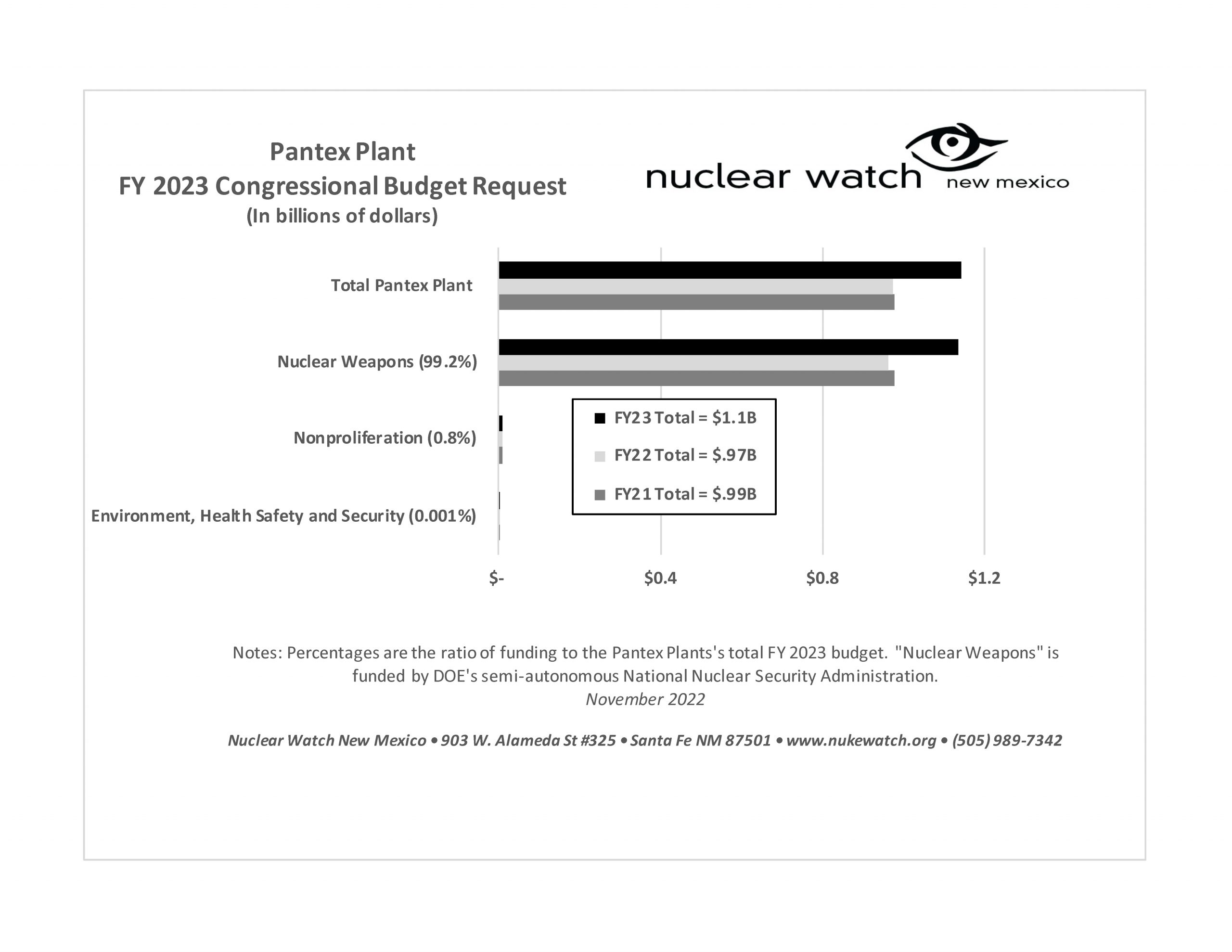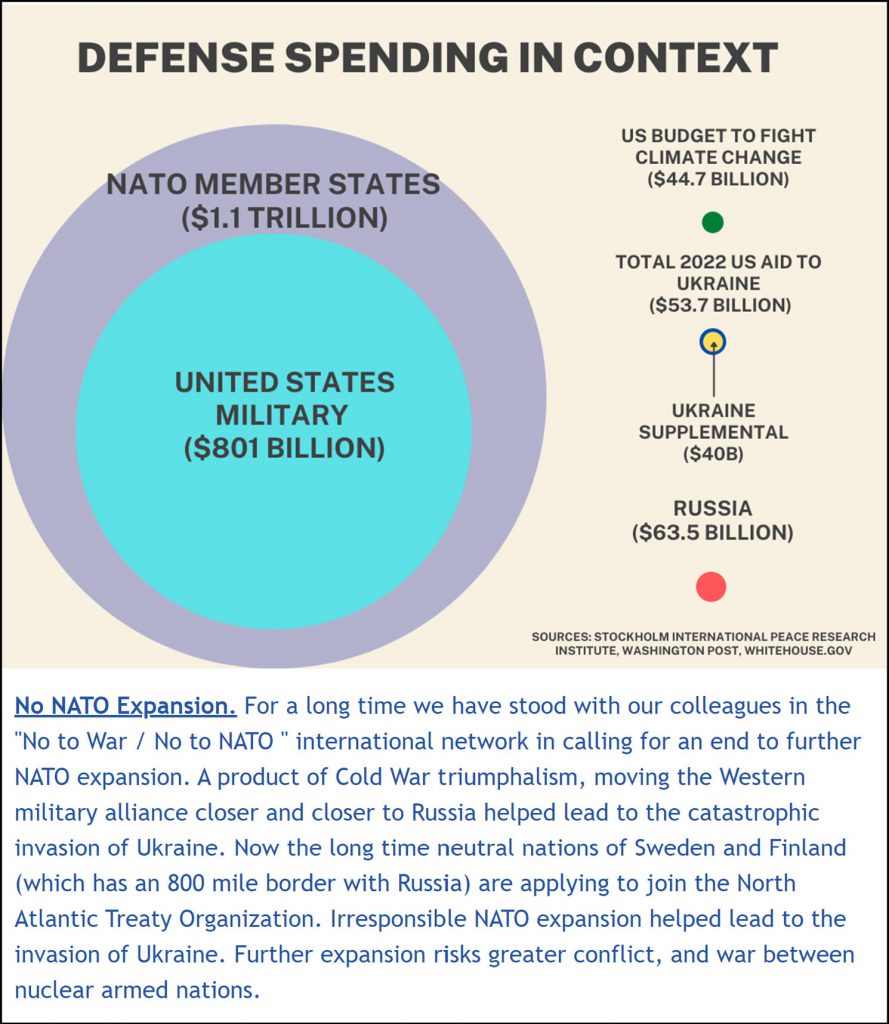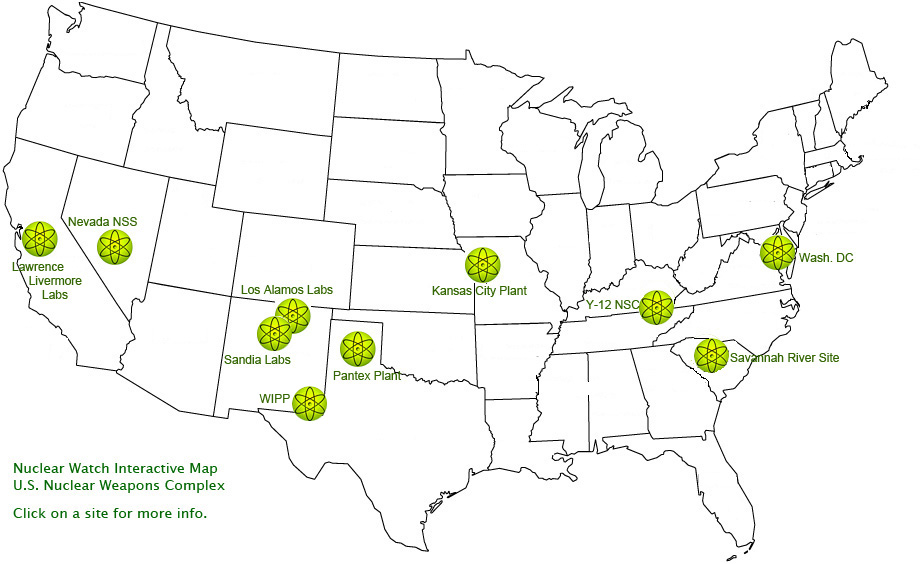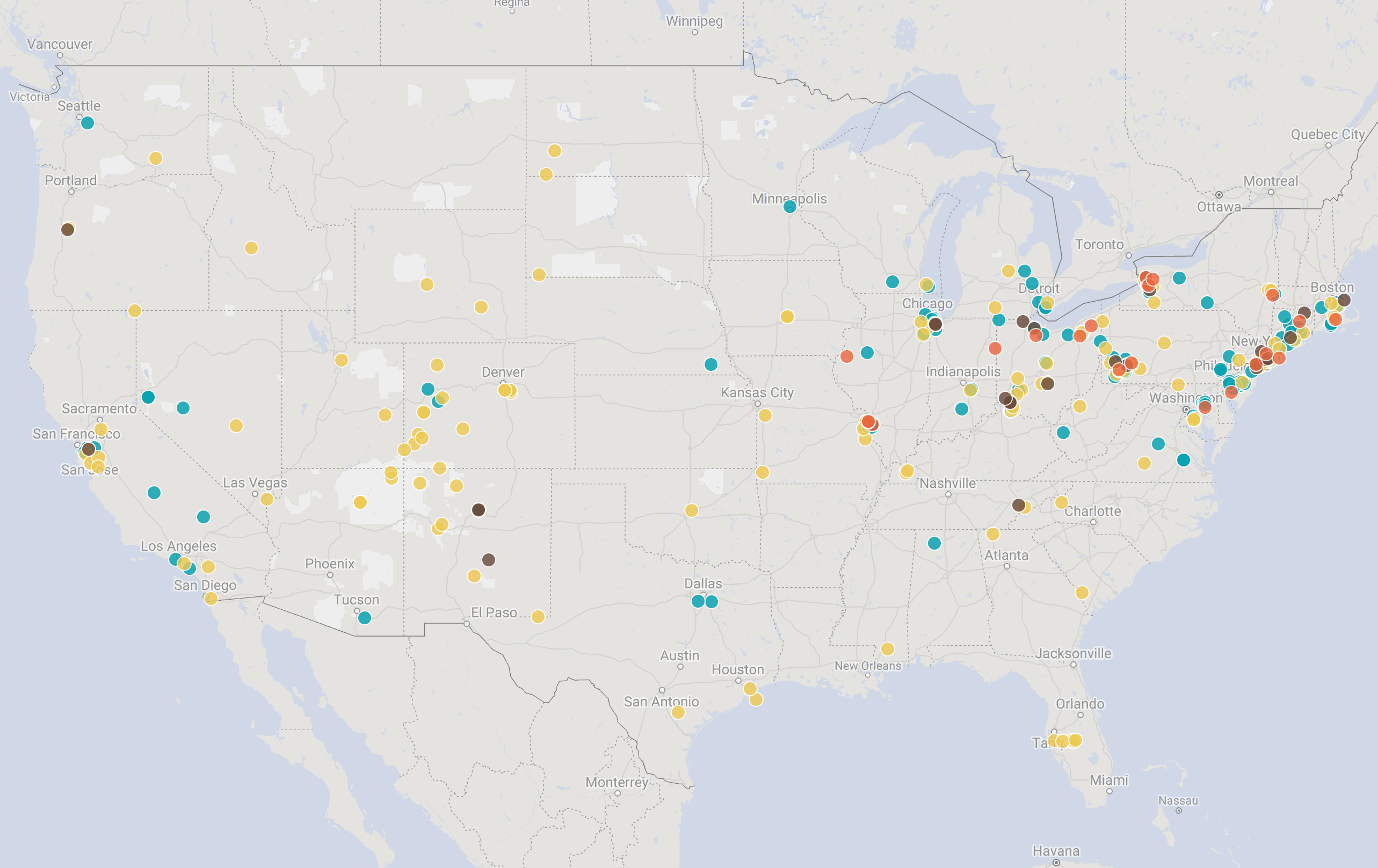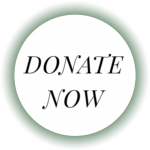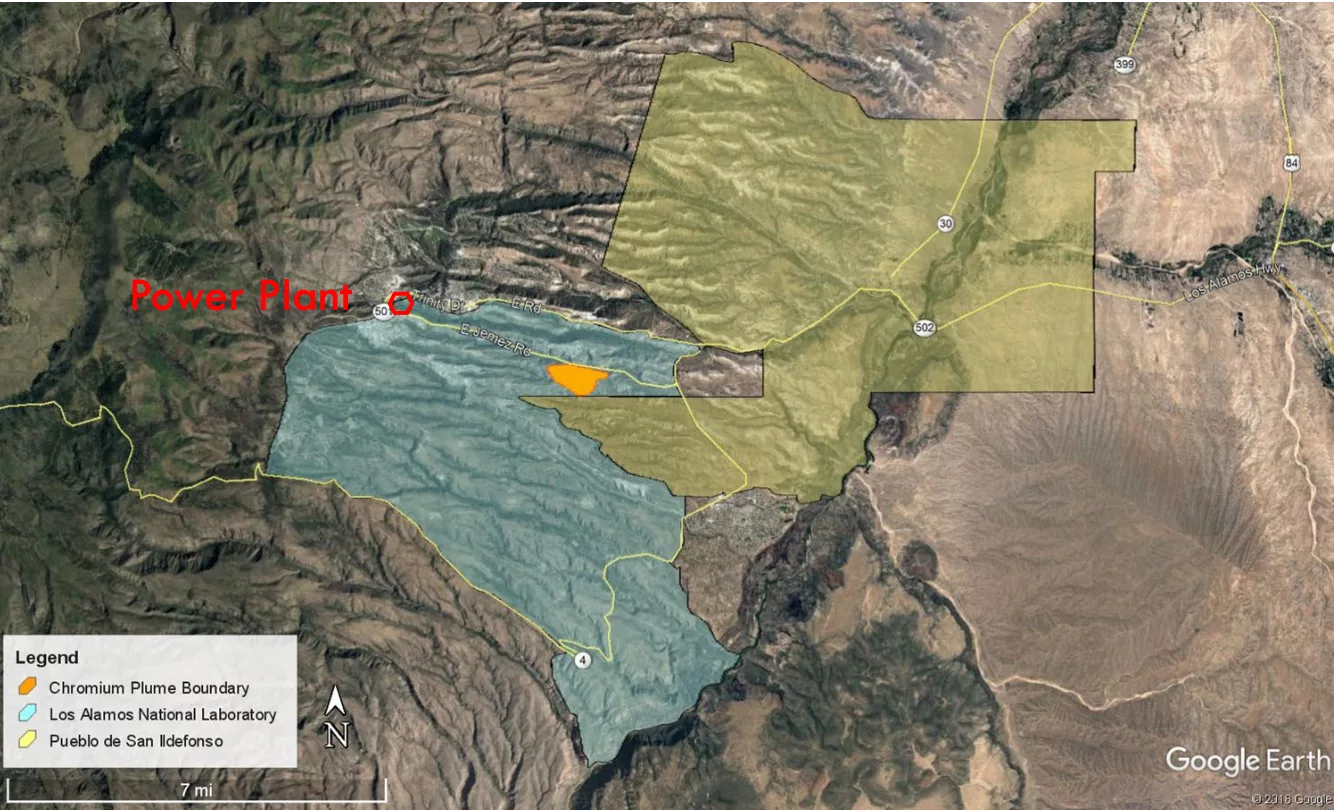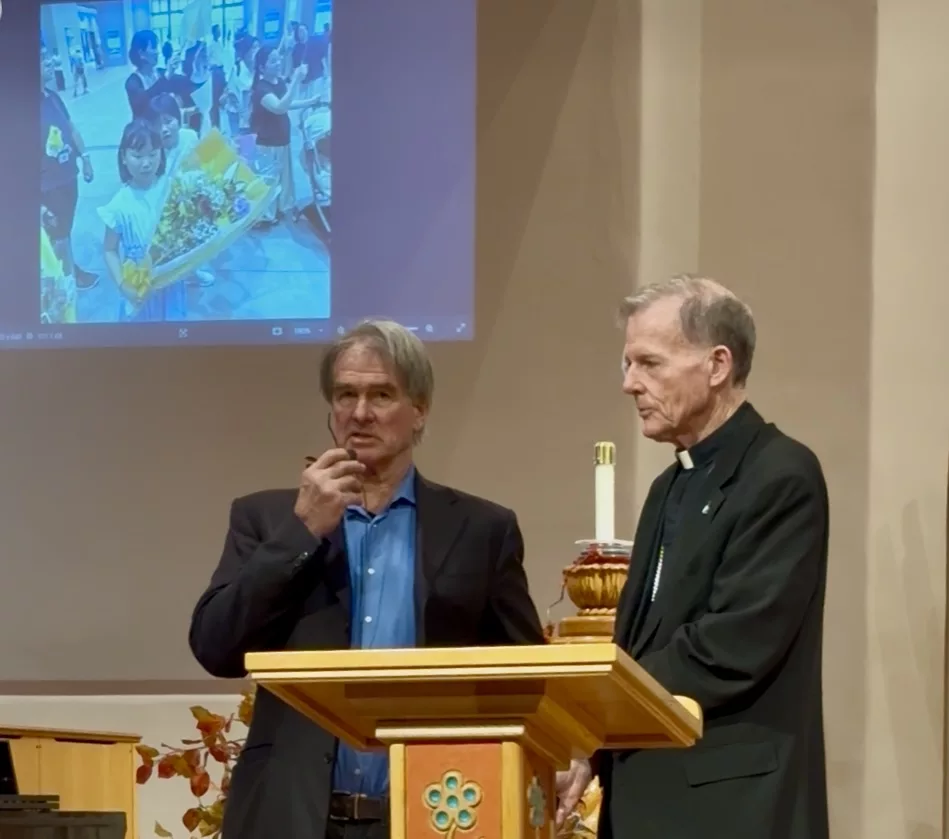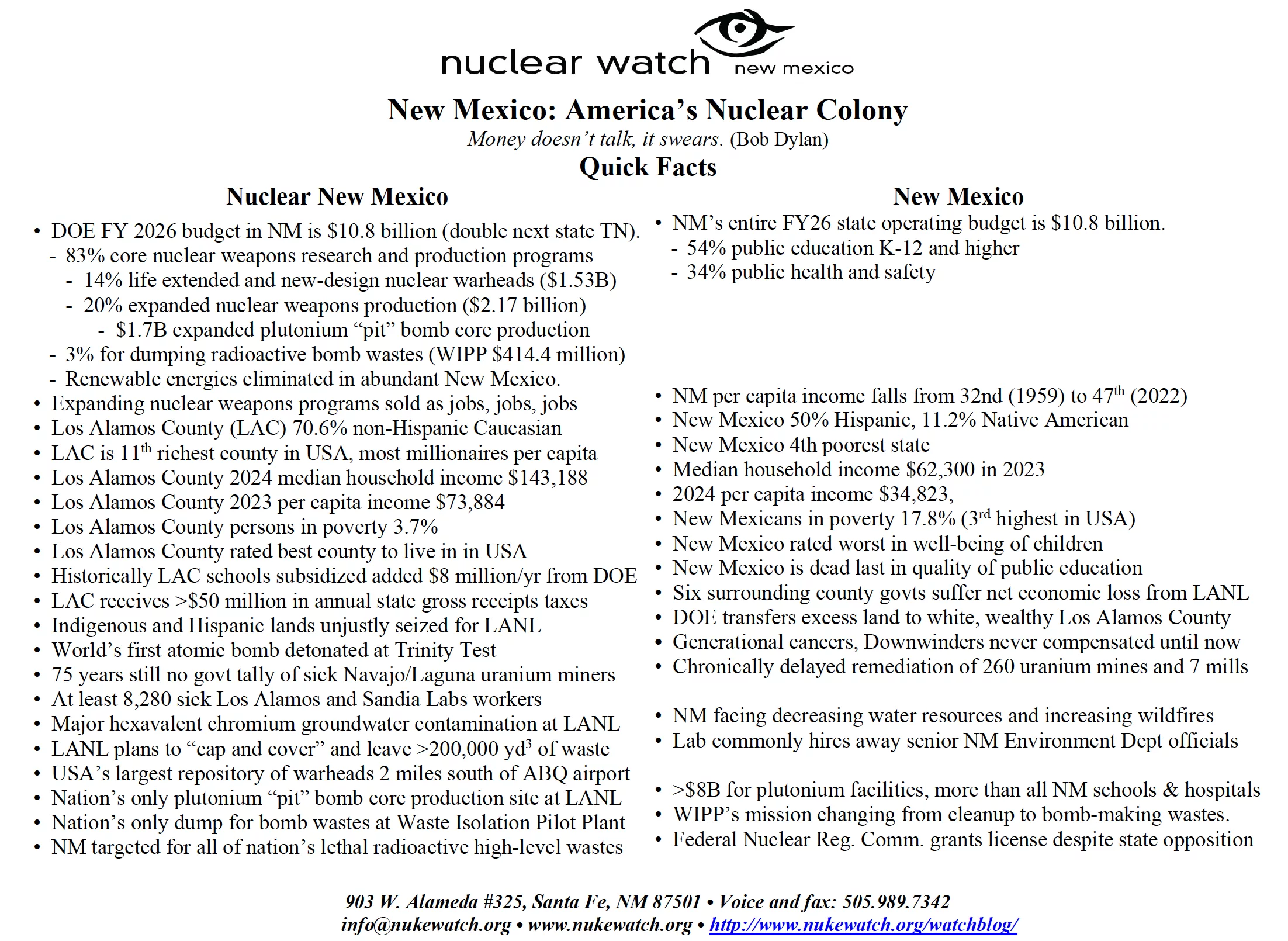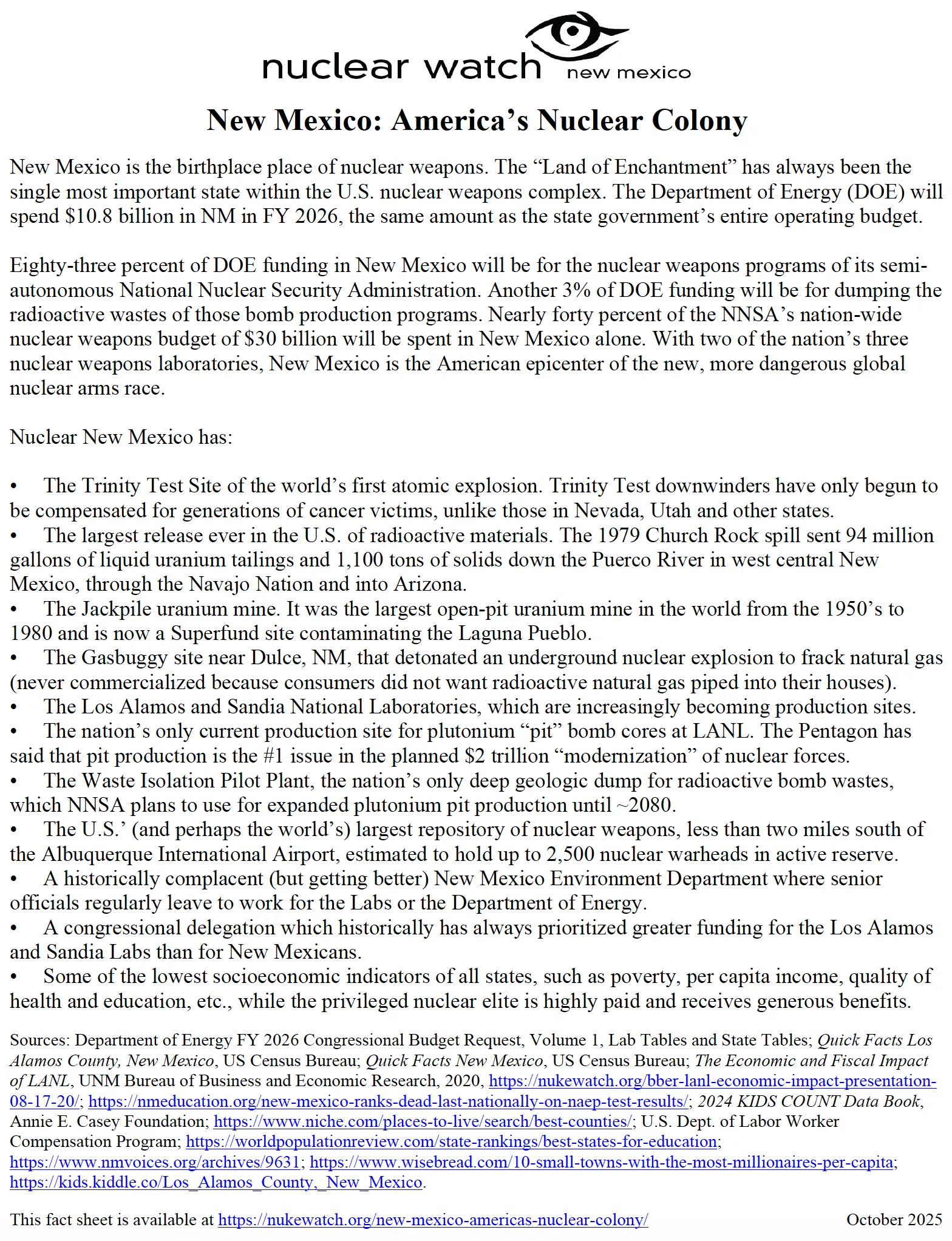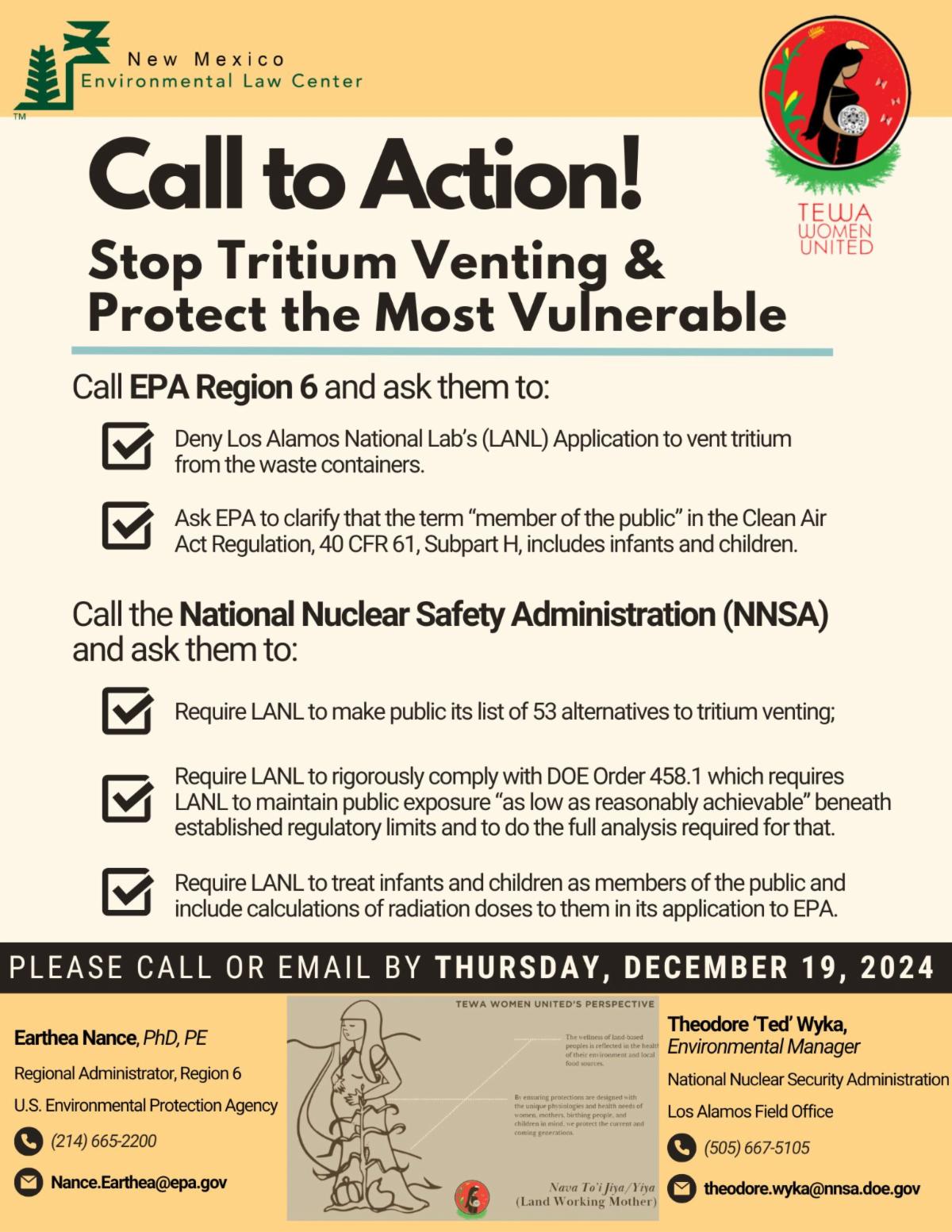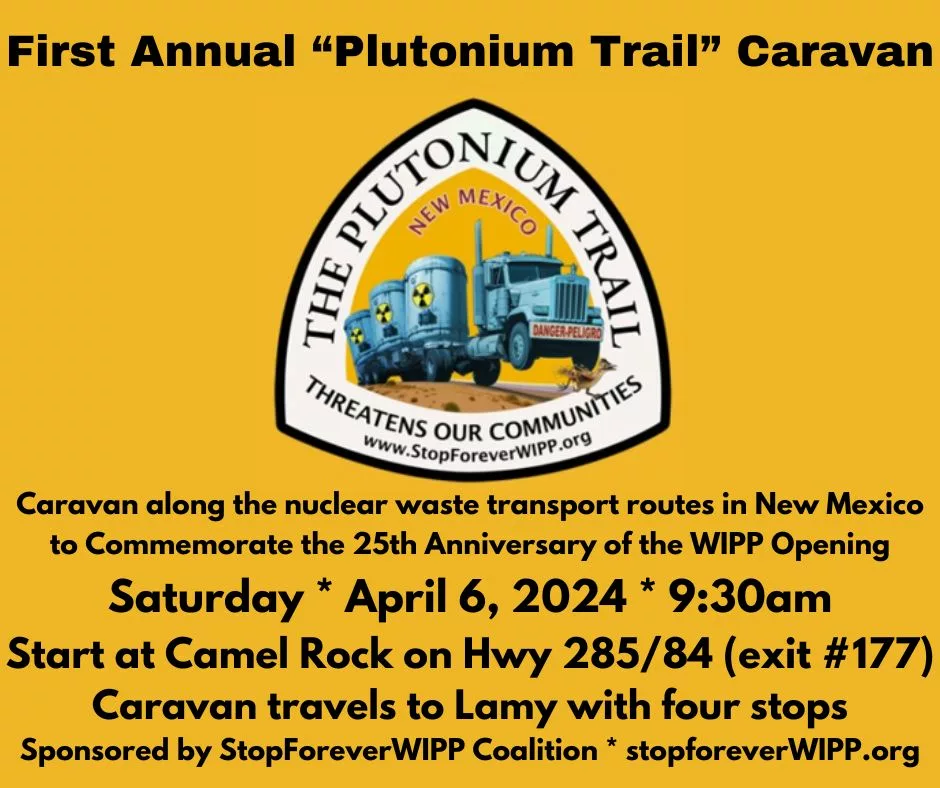QUOTE OF THE WEEK
Trump’s Talk of Nuclear Tests Recalls Fears of the Cold War
“Yes, we can learn things by nuclear testing. But when you look at the big picture, we have much more to lose by going back to testing than we have to gain.”
– SIEGFRIED S. HECKER, a former director of the Los Alamos weapons lab in New Mexico, where the first atomic bomb was created, after President Trump’s call to resume nuclear testing revived a Cold War debate. The New York Times nytimes.com
LANL’s Central Mission: Los Alamos Lab officials have recently claimed that LANL has moved away from primarily nuclear weapons to “national security”, but what truly remains as the Labs central mission? Here’s the answer from one of its own documents:
LANL’s “Central Mission”- Presented at: RPI Nuclear Data 2011 Symposium for Criticality Safety and Reactor Applications (PDF) 4/27/11
Banner displaying “Nuclear Weapons Are Now Illegal” at the entrance in front of the Los Alamos National Lab to celebrate the Entry Into Force of the Nuclear Weapon Ban Treaty on January 22, 2021
“There is nothing comparable in our history to the deceit and the lying that took place as a matter of official Government policy in order to protect this industry. Nothing was going to stop them and they were willing to kill our own people.”
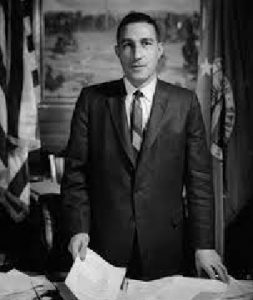
— Stewart Udall, United States Secretary of the Interior under President Kennedy and President Johnson.
He was the father of Senator Tom Udall (who ended up being a vigorous supporter of expanded nuclear weapons “modernization” plans).
Follow the Money!
Map of “Nuclear New Mexico”
Nuclear Watch Interactive Map – U.S. Nuclear Weapons Complex
In 1985, US President Ronald Reagan and and Russian President Mikhail Gorbachev declared that “a nuclear war cannot be won and must never be fought.”
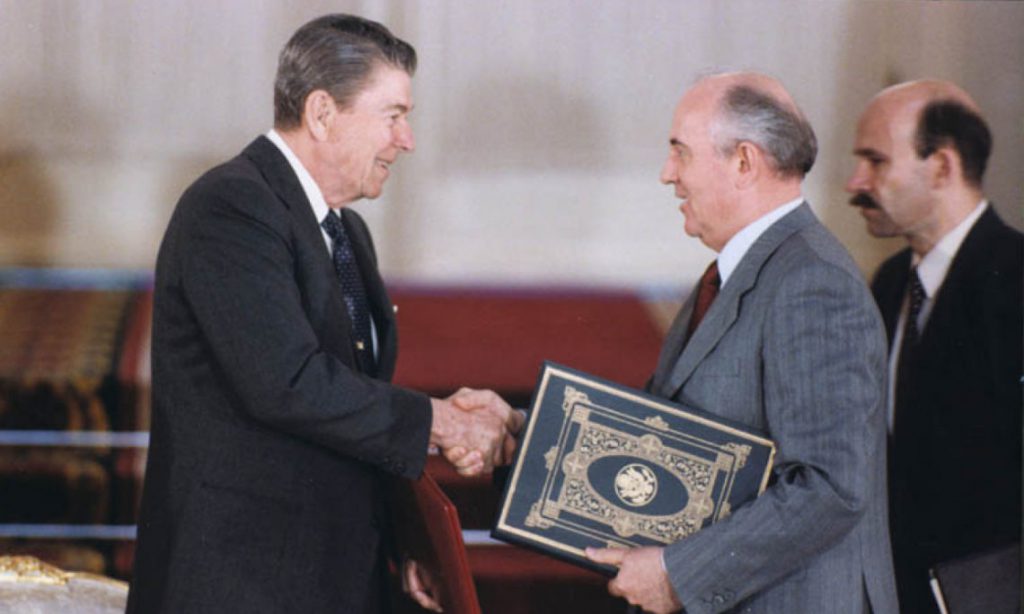
Waste Lands: America’s Forgotten Nuclear Legacy
The Wall St. Journal has compiled a searchable database of contaminated sites across the US. (view)
Related WSJ report: https://www.wsj.com
2022 BLOG POSTS
Lab Chromium Contamination Confirmed on San Ildefonso Pueblo Land
Comprehensive Cleanup Needed Instead of More Nuclear Weapons
The New Mexico Environment Department has announced:
“A toxic chromium plume from Los Alamos National Laboratory has spread beyond Lab boundaries onto Pueblo de San Ildefonso land for the first time, with contamination exceeding state groundwater standards… These new results are conclusive evidence that the U.S. Department of Energy’s efforts to contain the chromium plume have been inadequate.”
In reality, chromium groundwater contamination probably migrated beyond the LANL/San Ildefonso Pueblo boundary long ago, with past Lab maps of the plume “magically’ stopping at the border. In the past, tribal leadership has commented that it was fortunate that the contamination stopped there, but that any future indications of groundwater contamination on Pueblo land could have serious consequences. The San Ildefonso Pueblo is a sovereign Native American tribal government.
As late as the late 1990s the Lab was falsely claiming that groundwater contamination was impossible because underlying volcanic tuff is “impermeable.” [1] This ignored the obvious fact that the Parajito Plateau is heavily seismically fractured, providing ready pathways for contaminant migration to deep groundwater. By 2005 even LANL acknowledged that continuing increasing contamination of the regional aquifer is inevitable.[2] Some 300,000 northern New Mexicans rely upon the aquifer for safe drinking water. The potential serious human health effects (including cancer) caused by chromium contamination was the subject of the popular movie Erin Brockovich.
LANL Prioritizes Plutonium “Pit” Bomb Core Production Over Safety
The independent Defense Nuclear Facilities Safety Board recently released its Review of the Los Alamos Plutonium Facility Documented Safety Analysis. It concluded that:
“While LANL facility personnel continue to make important upgrades to the Plutonium Facility’s safety systems, many of those projects have encountered delays due to inconsistent funding and other reasons. DOE and LANL should consider prioritizing safety-related infrastructure projects to ensure that the Plutonium Facility safety strategy adequately protects the public, as the facility takes on new and expansive national security missions.” (Page 24)
In early October 2024, the Department of Energy’s semi-autonomous National Nuclear Security Administration (NNSA) announced with great fanfare that the Los Alamos Lab had produced its first “diamond stamped” plutonium pit for the nuclear weapons stockpile. Tens of billions of taxpayers’ dollars have been sunk into LANL’s long delayed and over budget pit production program. Given no further announcements, it is not currently known whether or not the Lab is meeting its congressionally required production goals. Endemic nuclear safety problems have long been an intractable issue, at one point even forcing a three-year halt to plutonium operations at LANL’s Plutonium Facility-4 (“PF-4”).
In its recent Review, the Safety Board reported:
“The [2009] Plutonium Facility safety basis described very large potential [radioactive] dose consequences to the public following seismic events…. DOE committed to upgrade and seismically qualify the ventilation system, with a particular focus on a specific ventilation subsystem…”
“As the only facility in the DOE complex that can process large quantities of plutonium in many forms, [PF-4] represents a unique capability for the nation’s nuclear deterrent. The Board has long advocated for the use of safety-related active confinement systems in nuclear facilities for the purposes of confining radioactive materials…Passive confinement systems are not necessarily capable of containing hazardous materials with confidence because they allow a quantity of unfiltered air contaminated with radioactive material to be released from an operating nuclear facility following certain accident scenarios. Safety related active confinement ventilation systems will continue to function during an accident, thereby ensuring that radioactive material is captured by filters before it can be released into the environment… (Page 2, bolded emphases added)
Trump Orders Nuclear Weapons Testing for New Nuclear Arms Race
New Plutonium “Pit” Bomb Cores at Los Alamos Lab Could Make It Real
Just minutes before meeting with Chinese President Xi Jinping, Trump posted on his Truth Social media platform that “Because of other countries testing programs, I have instructed the Department of War to start testing our Nuclear Weapons on an equal basis. That process will begin immediately.” House Speaker Mike Johnson soon followed on CNN saying, “I think it is an obvious and logical thing to ensure that our weapons systems work.”
No other countries are currently testing nuclear weapons (the last was by North Korea in 2017). Further, any nuclear weapons tests by the U.S. would be performed by the Department of Energy (whose last test was in 1992), not the Department of War (until recently the Department of Defense). Trump was likely referring to Vladimir Putin’s recent claims of a new nuclear powered cruise missile and a tsunami-causing nuclear-armed torpedo that could threaten America’s coastal cities. In addition, China is dramatically expanding its own fleet of intercontinental ballistic missiles.
But central to all this is the U.S.’ own $2 trillion “modernization” program that will rebuild every nuclear warhead in the planned stockpile with new military capabilities and produce new-design nuclear weapons as well. This so-called modernization program will also build new nuclear weapons production facilities expected to be operational until ~2080, and buy new missiles, subs, and bombers from the usual rich defense contractors, all to keep nuclear weapons forever.
New Mexico’s Revolving Nuclear Door: Top Environment Officials Sell Out to Nuclear Weapons Labs
As part of a long, ingrained history, senior officials at the New Mexico Environment Department (NMED) have repeatedly resigned to go to work for the nuclear weapons labs, the Department of Energy, or DOE contractors. In a number of cases that is where they came from to begin with.
The hierarchy of leadership at NMED starts with the Secretary, Deputy Secretaries and then Division Directors. The position of Resource Protection Division Director is particularly critical because it oversees the two NMED bureaus most directly involved with DOE facilities in New Mexico, the Hazardous Waste Bureau and the DOE Oversight Bureau.
FULL PRESS RELEASE [PDF]
Biden’s Nuclear Posture Review Fuels the New Nuclear Arms Race
FOR IMMEDIATE RELEASE, October 27, 2022 |
Jay Coghlan, 505.989.7342 jay@nukewatch.org
Santa Fe, NM– Today, the Biden Administration has released its long awaited unclassified Nuclear Posture Review. It headlines a “Comprehensive, balanced approach to defending vital national security interests and reducing nuclear dangers.” It also declares that “deterrence alone will not reduce nuclear dangers.”
“Deterrence” against others has always been the publicly sold rationale for the United States’ nuclear weapons stockpile. First, there is the inconvenient fact that the U.S. was the first and only to use nuclear weapons in war. But secondly, the United States and the USSR (now Russia) never possessed their huge stockpiles for the sole purpose of deterrence anyway. Instead, their nuclear weapons policies have always been a hybrid of deterrence and nuclear war fighting, which threatens global annihilation to this very day.
FULL PRESS RELEASE [PDF]
The Cuban Missile Crisis 60 Years Ago, Ukraine Today: What, if Anything, Have we Learned?
/cdn.vox-cdn.com/uploads/chorus_image/image/71550878/GettyImages_515016314a.0.jpg)
By: Sophia Stroud | October 27, 2022
The 60th anniversary of the Cuban Missile Crisis this year coincides with a world again in a moment of impeding nuclear conflict with the perilous escalation of the situation in Ukraine. The Cuban Missile Crisis has been viewed as the defining confrontation of the modern age, the world’s closest brush with nuclear annihilation, until now. But “the war in Ukraine presents perils of at least equal magnitude.” The world is again on the brink of nuclear war. Russian Foreign Minister Sergey Lavrov has said bluntly “there are ‘similarities’ [of the Ukraine War] to the Cuban crisis,” mainly because Russia was now threatened by Western weapons in Ukraine. But how can we get a deeper understanding besides this surface comparison? Now seems like a good time to analyze, not what the lessons of the Cuban missile crisis are for us now, but what, if anything, have we learned from these lessons that we have supposedly have already identified by now, far past half a century later? Have these lessons really taught us anything or are “the Lessons of the Cuban Missile Crisis [Actually] Pretty Useless Right Now“?
Continue reading
New & Updated
Lab Chromium Contamination Confirmed on San Ildefonso Pueblo Land
Comprehensive Cleanup Needed Instead of More Nuclear Weapons
FOR IMMEDIATE RELEASE, November 14, 2025
Contact: Jay Coghlan, 505.989.7342, c. 505.470.3154 | Email
Contact: Scott Kovac, 505.316.4148 | Email
Santa Fe, NM – The New Mexico Environment Department has announced:
“A toxic chromium plume from Los Alamos National Laboratory has spread beyond Lab boundaries onto Pueblo de San Ildefonso land for the first time, with contamination exceeding state groundwater standards… These new results are conclusive evidence that the U.S. Department of Energy’s efforts to contain the chromium plume have been inadequate.”
In reality, chromium groundwater contamination probably migrated beyond the LANL/San Ildefonso Pueblo boundary long ago, with past Lab maps of the plume “magically’ stopping at the border. In the past, tribal leadership has commented that it was fortunate that the contamination stopped there, but that any future indications of groundwater contamination on Pueblo land could have serious consequences. The San Ildefonso Pueblo is a sovereign Native American tribal government.
As late as the late 1990s the Lab was falsely claiming that groundwater contamination was impossible because underlying volcanic tuff is “impermeable.” [1] This ignored the obvious fact that the Parajito Plateau is heavily seismically fractured, providing ready pathways for contaminant migration to deep groundwater. By 2005 even LANL acknowledged that continuing increasing contamination of the regional aquifer is inevitable.[2] Some 300,000 northern New Mexicans rely upon the aquifer for safe drinking water. The potential serious human health effects (including cancer) caused by chromium contamination was the subject of the popular movie Erin Brockovich.
LANL chromium plume spreads onto San Ildefonso Pueblo land, NMED says
Nuclear Watch New Mexico executive direcor Jay Coghlan sees PF-4 as being a bigger scale — and having bigger risks — than the other aging buildings.
“PF-4 is not unique in being old,” Coghlan said. “However, PF-4 is totally unique in currently being the only facility that can process large amounts of plutonium … particularly including plutonium pit production. I think, in part, that’s why the Safety Board focuses more on PF-4 than, to my knowledge, than any other single individual facility.”
By:Patrick Lohmann | November 13, 2025 sourcenm.com
An underground plume of toxic chromium has spread from Los Alamos National Laboratory to Pueblo de San Ildefonso land, state Environment Department officials announced Thursday.
The discovery marks the first time the plume has been detected within the pueblo boundaries, officials said in a news release, though they added the plume’s spread does not pose imminent threats to drinking water in the pueblo or in Los Alamos County. That’s because the plume is not near any known private or public wells, officials said.
Long-term ingestion of hexavalant chromium can cause serious health problems or increase risk of certain cancers.
US Stands Alone Defying UN Vote on Nuclear Test Ban Treaty
Could the LDS Church end an ongoing nuclear weapons project? These veteran activists think so.
By Thalif Deen, Inter Press Sevice | November 12, 2025 ipsnews.net
UNITED NATIONS, Nov 12 2025 (IPS) – The US took another step backward –to break ranks with the United Nations– when it voted against a draft resolution calling for the entry into force of the Comprehensive Nuclear-Test-Ban Treaty (CTBT).
The negative vote followed an announcement by President Trump last month that the US plans to resume nuclear testing after a 33-year hiatus. The US stood alone on the UN vote, which was supported by almost all member States in the General Assembly’s First Committee.
The resolution was adopted by an overwhelming majority: with 168 votes in favor, with one against (United States) and 3 abstentions (India, Mauritius, Syria).
During Trump’s first term, the US abstained on the vote. And in other years they had been voting in favour.
Jackie Cabasso, Executive Director, Western States Legal Foundation, which monitors and analyzes U.S. nuclear weapons programs and policies, told IPS the chaos and uncertainty arose from Trump’s factually-challenged social media post that “because of other countries testing programs, I have instructed the Department of War to start testing our Nuclear Weapons on an equal basis.”
The U.S. government’s first ever “No” vote, on the annual UN resolution in support of the Comprehensive Test Ban Treaty (CTBT), raises further troubling questions about U.S. intentions.
Harking to the MX, Utahns call on LDS Church President Oaks to speak out against nuclear missile being developed in Utah
Could the LDS Church end an ongoing nuclear weapons project? These veteran activists think so.
THE SALT LAKE TRIBUNE | November 9, 2025 sltrib.com
Decades ago, peace activists helped keep a major nuclear weapons system out of Utah with help from key figures, chiefly Spencer W. Kimball, then the president of The Church of Jesus Christ of Latter-day Saints.
Now some of those same individuals are calling on the church’s newly ascended president, Dallin H. Oaks, to follow in his predecessor’s footsteps and speak out against the federal government’s development of a new generation of nuclear missile, known as Sentinel, partly in the Beehive State.
“The arms race continues,” the group of 12 Utahns and one former resident write in a letter mailed to church headquarters in early October, “and a new moral challenge faces” the leaders of the Utah-based faith.
LANL Prioritizes Plutonium “Pit” Bomb Core Production Over Safety
FOR IMMEDIATE RELEASE, November 6, 2025
Contact: Jay Coghlan, 505.989.7342, c. 505.470.3154 | Email
Contact: Scott Kovac, 505.316.4148 | Email
Santa Fe, NM – The independent Defense Nuclear Facilities Safety Board recently released its Review of the Los Alamos Plutonium Facility Documented Safety Analysis. It concluded that:
“While LANL facility personnel continue to make important upgrades to the Plutonium Facility’s safety systems, many of those projects have encountered delays due to inconsistent funding and other reasons. DOE and LANL should consider prioritizing safety-related infrastructure projects to ensure that the Plutonium Facility safety strategy adequately protects the public, as the facility takes on new and expansive national security missions.” (Page 24)
In early October 2024, the Department of Energy’s semi-autonomous National Nuclear Security Administration (NNSA) announced with great fanfare that the Los Alamos Lab had produced its first “diamond stamped” plutonium pit for the nuclear weapons stockpile. Tens of billions of taxpayers’ dollars have been sunk into LANL’s long delayed and over budget pit production program. Given no further announcements, it is not currently known whether or not the Lab is meeting its congressionally required production goals. Endemic nuclear safety problems have long been an intractable issue, at one point even forcing a three-year halt to plutonium operations at LANL’s Plutonium Facility-4 (“PF-4”).
In its recent Review, the Safety Board reported:
“The [2009] Plutonium Facility safety basis described very large potential [radioactive] dose consequences to the public following seismic events…. DOE committed to upgrade and seismically qualify the ventilation system, with a particular focus on a specific ventilation subsystem…”
“As the only facility in the DOE complex that can process large quantities of plutonium in many forms, [PF-4] represents a unique capability for the nation’s nuclear deterrent. The Board has long advocated for the use of safety-related active confinement systems in nuclear facilities for the purposes of confining radioactive materials…Passive confinement systems are not necessarily capable of containing hazardous materials with confidence because they allow a quantity of unfiltered air contaminated with radioactive material to be released from an operating nuclear facility following certain accident scenarios. Safety related active confinement ventilation systems will continue to function during an accident, thereby ensuring that radioactive material is captured by filters before it can be released into the environment… (Page 2, bolded emphases added)
Los Alamos’ plutonium facility safety systems need improvement, oversight board says
Nuclear Watch New Mexico executive direcor Jay Coghlan sees PF-4 as being a bigger scale — and having bigger risks — than the other aging buildings.
“PF-4 is not unique in being old,” Coghlan said. “However, PF-4 is totally unique in currently being the only facility that can process large amounts of plutonium … particularly including plutonium pit production. I think, in part, that’s why the Safety Board focuses more on PF-4 than, to my knowledge, than any other single individual facility.”
By Alaina Mencinger amencinger@sfnewmexican.com | November 7, 2025 santafenewmexican.com
An independent oversight agency wants to see improved safety systems at the facility at the heart of Los Alamos National Laboratory’s plutonium pit mission: PF-4.
The Defense Nuclear Facilities Safety Board reported what it believes to be gaps in a safety analysis drafted for PF-4 and delays in upgrades to safety systems in a letter last month to Energy Secretary Chris Wright.
“Maintaining momentum for these safety infrastructure projects is more important in light of the issues with the safety analysis,” the board wrote in the letter dated Oct. 10. It was signed by former acting chairman Thomas Summers.
Trump Orders Nuclear Weapons Testing for New Nuclear Arms Race
New Plutonium “Pit” Bomb Cores at Los Alamos Lab Could Make It Real
FOR IMMEDIATE RELEASE, October 30, 2025
Contact: Jay Coghlan, 505.989.7342, c. 505.470.3154 | Email
Santa Fe, NM – Just minutes before meeting with Chinese President Xi Jinping, Trump posted on his Truth Social media platform that “Because of other countries testing programs, I have instructed the Department of War to start testing our Nuclear Weapons on an equal basis. That process will begin immediately.” House Speaker Mike Johnson soon followed on CNN saying, “I think it is an obvious and logical thing to ensure that our weapons systems work.”
No other countries are currently testing nuclear weapons (the last was by North Korea in 2017). Further, any nuclear weapons tests by the U.S. would be performed by the Department of Energy (whose last test was in 1992), not the Department of War (until recently the Department of Defense). Trump was likely referring to Vladimir Putin’s recent claims of a new nuclear powered cruise missile and a tsunami-causing nuclear-armed torpedo that could threaten America’s coastal cities. In addition, China is dramatically expanding its own fleet of intercontinental ballistic missiles.
But central to all this is the U.S.’ own $2 trillion “modernization” program that will rebuild every nuclear warhead in the planned stockpile with new military capabilities and produce new-design nuclear weapons as well. This so-called modernization program will also build new nuclear weapons production facilities expected to be operational until ~2080, and buy new missiles, subs, and bombers from the usual rich defense contractors, all to keep nuclear weapons forever.
San Francisco officials give update after airborne plutonium detected
Public health officials in San Francisco said no “immediate action” is needed to protect public safety after airborne plutonium was detected in the city.
By Gillian Mohney | November 3, 2025 sfgate.com
In 2024, the radioactive substance Pu-239 was detected in the former Hunters Point Naval Shipyard, which was used as a repair shipyard for the U.S. Navy for nearly 30 years. The plutonium was detected in an air filter in November 2024, but the San Francisco Health Department said in a letter to Navy officials that it was not alerted until last month.
In an emailed statement, Dr. Susan Philip, the public health officer for San Francisco, told SFGATE she met with Navy officials last week to discuss the public health concerns.
“During this meeting, Navy officials confirmed that dust-control measures, and air and dust monitoring are ongoing,” Philip told SFGATE. “The Navy has also stated that they are reviewing their dust control methods to ensure they are fully protective of public health. Based on the information currently provided by the Navy, no immediate action is required from a public health safety standpoint.”
[…]
Pu-239 has a half-life of over 24,000 years and can stay in the body for decades even if ingested or inhaled in small amounts, potentially increasing the risk of developing cancer.
AP: Trump appears to suggest the US will resume testing nuclear weapons for first time in 30 years
“For Trump, who has cast Russia as a “paper tiger” for failing to swiftly subdue Ukraine, the message is that Russia remains a global military competitor, especially on nuclear weapons, and that Moscow’s overtures on nuclear arms control should be acted on.”
By MICHELLE L. PRICE and CHRIS MEGERIAN | October 30, 2025 apnews.com
BUSAN, South Korea (AP) — President Donald Trump appeared to suggest the U.S. will resume testing nuclear weapons for the first time in three decades, saying it would be on an “equal basis” with Russia and China.
The Kremlin pointed out that a global ban on nuclear tests has remained in place, but warned that if any country resumes nuclear testing Russia would follow suit.
There was no indication the U.S. would start detonating warheads, but Trump offered few details about what seemed to be a significant shift in U.S. policy.
He made the announcement on social media minutes before he met with Chinese leader Xi Jinping on Thursday in South Korea. He offered little clarity when he spoke to reporters later aboard Air Force One as he flew back to Washington.
The U.S. military already regularly tests its missiles that are capable of delivering a nuclear warhead, but it has not detonated the weapons since 1992. The Comprehensive Nuclear Test Ban Treaty, which the U.S. signed but did not ratify, has been observed since its adoption by all countries possessing nuclear weapons, North Korea being the only exception.
REUTERS: Trump tells Pentagon to immediately resume testing US nuclear weapons
“Russia – which tested a new nuclear-powered cruise missile on October 21, held nuclear readiness drills on October 22 and tested a new nuclear-powered autonomous torpedo on October 28 – said it hoped Trump had been properly informed that Moscow had not tested a nuclear weapon itself.”
By Trevor Hunnicutt, Ismail Shakil and Kanishka Singh | October 30, 2025 reuters.com
VIEW THE RECORDING: Santa Fe Ecumenical Conversations Towards Nuclear Disarmament at Santa Maria de la Paz Catholic Community – Monday, October 27
Archbishop John C. Wester and NukeWatch New Mexico presented a special evening at Santa Maria de la Paz Catholic Community on Monday, October 27, from 6:00 to 8:00 p.m. MT. Following a presentation from NukeWatch executive director Jay Coghlan on U.S. nuclear weapons “modernization,” the Archbishop shared reflections from his pastoral letter, Living in the Light of Christ’s Peace, and speak about the importance of dialogue and hope in working toward nuclear disarmament.
View the recording at https://www.youtube.com/watch?v=9LFmQzMoJds&t=1s
‘Nuclear weapons are blasphemous’: Archbishop Wester continues disarmament push with talk
This event was organized by the “Santa Fe Ecumenical Conversations Towards Nuclear Disarmament” group at the Santa Maria de la Paz parish near the Santa Fe Community College. They kindly invited NukeWatch to speak before Archbishop Wester for what turned out to be a wonderful event. The full recording can be viewed at https://www.youtube.com/@SMDLP/streams
By Cormac Dodd cdodd@sfnewmexican.com | October 28, 2025 santafenewmexican.com
Despite saying he has received a somewhat muted response from the local faithful, Santa Fe’s Catholic archbishop is still pushing nuclear disarmament as vital to humanity’s spiritual well-being and continued existence.
“I think nuclear weapons are blasphemous, because I think nuclear weapons are humanity’s attempt to build a Tower of Babel, an attempt to eat from the apple of the tree of the Garden of Eden, to become like God, to become gods,” Archbishop John C. Wester said in a roughly 30-minute address at Santa Maria de la Paz Catholic Church south of Santa Fe.
“In humility, we must avoid inventing anything that, in a matter of hours, can destroy what God has created,” the leader of the Archdiocese of Santa Fe continued. “The story of Adam and Eve is archetypal, I think: When human beings try to become as God, they lose the Garden of Eden and they must endure the cruel reality of paradise lost.”
The archbishop’s comments followed a journey he undertook to Japan on the 80th anniversary of the U.S. military’s decision to drop atomic bombs on Hiroshima and Nagasaki toward the end of World War II. He spoke in front of an audience of about 50 people — who gave Wester a standing ovation — at Monday’s event
In a Looming Nuclear Arms Race, Aging Los Alamos Faces a Major Test
The lab where Oppenheimer developed the atomic bomb is the linchpin in the United States’ effort to modernize its nuclear weapons. Yet the site has contended with contamination incidents, work disruptions and old infrastructure.
By Alicia Inez Guzmán | October 28, 2025 The New York Times nytimes.com
In a sprawling building atop a mesa in New Mexico, workers labor around the clock to fulfill a vital mission: producing America’s nuclear bomb cores.
The effort is uniquely challenging. Technicians at Los Alamos National Laboratory must handle hazardous plutonium to create the grapefruit-size cores, known as pits. They do so in a nearly 50-year-old building under renovation to address aging infrastructure and equipment breakdowns that have at times disrupted operations or spread radioactive contamination, The New York Times found.
Now, the laboratory is under increasing pressure to meet the federal government’s ambitions to upgrade the nation’s nuclear arsenal. The $1.7 trillion project includes everything from revitalizing missile silos burrowed deep in five states, to producing new warheads that contain the pits, to arming new land-based missiles, bomber jets and submarines.
But the overall modernization effort is years behind schedule, with costs ballooning by the billions, according to the Congressional Budget Office. In 2018, Congress charged Los Alamos with making an annual quota of 30 pits by 2026, but by last year it had produced just one approved for the nuclear stockpile. (Officials have not disclosed whether more have been made since then.)
*The featured image differs from the article photo due to usage rights.
Why Putin’s ‘invincible’ nuclear-powered missile is more likely to become a disastrous ‘flying Chernobyl’ for Russia
The US abandoned efforts to build nuclear-powered missile weapons during the 1950s arms race with the Soviet Union as a nuclear-powered missile would effectively be a huge radiation risk.
Jeffrey Lewis, a nuclear nonproliferation expert at Middlebury College, described it as a “tiny flying Chernobyl,” referencing the Soviet power plant that melted down and covered a 1,600-mile area with toxic radiation…While Lewis believes the Burevestnik is only capable of subsonic speed and easy to intercept, he warned that Russia’s ambition poses a return to the Cold War era.
“NATO aircraft could intercept it. The problem is that Burevestnik is yet another step in an arms race that offers no victory for either side,” he wrote on X.
By Ronny Reyes | October 28, 2025 nypost.com
Russian strongman Vladimir Putin’s latest threats that Moscow is preparing to deploy its new “invincible” nuclear-powered cruise missile has drawn a rebuke from President Trump and a reminder of America’s own nuclear might.
But experts say the Burevestnik missile could end up being more like a disastrous “flying Chernobyl” for Russia — and proves Putin is actually nervous about the possibility of the US giving Tomahawk cruise missiles to Ukraine.
George Barros, of the Washington-based Institute for the Study of War, described Putin’s ominous Sunday announcement as a form of fear mongering from a Kremlin afraid that the US could give Kyiv a much more conventional weapon — the tried and true Tomahawk.
ACTION ALERTS
Public Hearings: Submit Comments on the Draft LANL SWEIS
- Review and submit comments on the Draft LANL SWEIS through March 11, 2025.
- Comments may be submitted via one of the following means:
- By email to: LANLSWEIS@nnsa.doe.gov; By mail to Mr. Stephen Hoffman, LANL SWEIS Document Manager, DOE/NNSA, 3747 W. Jemez Road, Los Alamos, New Mexico 87544; Verbally at one of the public hearings; In written form at one of the public hearings
-
Public hearings are scheduled for:
- February 11, 2025, at the Santa Fe Community Convention Center, Sweeney Room, 1-4 p.m. and 5-8 p.m. There will be a virtual option for these two meeting. Virtual hearing access instructions (g., website link or phone number) will be announced at least 15 days before the hearing and will be published in local newspapers, noticed to the GovDelivery mailing list, and available on the following websites: https://www.energy.gov/nnsa/nnsa-nepa-reading-roomand https://www.energy.gov/nepa/public-comment-opportunities.
- February 12, 2025, in Española at Mision y Convento, 5-8 p.m. This meeting is in-person only.
- February 13, 2025, in Los Alamos at Fuller Lodge, Pajarito Room, 5-8 p.m. In-person only.
- Comments may be submitted via one of the following means:
Briefing on Plutonium Migration at the Los Alamos National Laboratory
Who: Nuclear Watch New Mexico and chemist Dr. Michael Ketterer, Professor Emeritus of Chemistry and Biochemistry at Northern Arizona University
What: Nuclear Watch has mapped plutonium migration based on sampling data from Intellus, the Lab’s environmental sampling database. Our map graphically demonstrates widespread contamination down the Rio Grande to Cochiti Lake and vertically to deep groundwater. We believe it shows the need for comprehensive cleanup at LANL instead of proposed “cap and cover” that will leave toxic and radioactive wastes permanently buried in unlined pits and trenches.
When: 11:00 am MT Thursday April 25, 2024
Where: https://us06web.zoom.us/j/95570087953?pwd=R1hNUEIyb1BLaktDQzZQaWNEdlpoQT09
Meeting ID: 922 1214 9822 Passcode: 975887
This virtual briefing is for media and the public. Nuclear Watch and Dr. Ketterer will briefly present followed by Q&A. Media and reporters will be given preference for questions. Please feel free to forward this notice to others.
Our plutonium contamination map and background materials will be available at www.nukewatch.org by 10:00 am MT Thursday April 25.
First Annual Plutonium Trail Caravan
On Saturday, April 6, you will be able to join the First Annual Plutonium Trail Caravan! It will start at Pojoaque and end at Lamy. It will also stop in Eldorado and you are welcome to join the caravan on its way to the final stop in Lamy. There will be several stops along the way, with more details coming soon. Please save the date for 30 minutes on the afternoon of April 6. There will be fun satiric songs, banners, and plenty of people to ask questions about risks to neighborhoods on the route.
WIPP Information Exchange Dec. 13 – In Person and Virtual
The U.S. Department of Energy (DOE) Carlsbad Field Office (CBFO) and Salado Isolation Mining Contractors (SIMCO) (Permittees) will conduct a virtual WIPP Information Exchange pursuant to Permit Part 4, Section 4.2.1.5, Legacy TRU Waste Disposal Plan. This exchange will discuss information regarding the Legacy TRU Waste Disposal Plan.
Questions and comments outside the scope of the Legacy TRU Waste Disposal Plan should be directed to the WIPP Community Forum.
Wednesday, December 13, 2023, 2 p.m. – 4 p.m.
Skeen-Whitlock Building
4021 National Parks Hwy
Carlsbad, NM 88220
REGISTRATION:
In-Person Registration:
WIPP Information Exchange In-Person Registration: https://form.jotform.com/222836798629172
Virtual Registration:
WIPP Information Exchange Virtual Registration:
QUESTIONS:
For questions regarding this information exchange please contact the WIPP Information Center at infocntr@wipp.ws or by calling 1-800-336-9477.
Upholding the CTBT Regime in a Time of Adversity
Thursday, Nov. 16, 10:00-11:30 am, U.S. Eastern Time
RSVP via Zoom by November 14
As with other critical nuclear risk reduction and arms control agreements, the 1996 Comprehensive Nuclear Test Ban Treaty (CTBT) is under threat due to inattention, diplomatic inaction, and worsening relations between nuclear-armed adversaries.
Disturbingly, but not surprisingly, Russian President Vladimir Putin has signed a bill from the Russian parliament to “un-ratify” the CTBT, ostensibly to “mirror” the United States’ posture toward the treaty and somehow pressure the United States to ratify the pact.
Putin says Russia will not resume nuclear explosive testing unless the United States does, but Russian officials have accused the United States of making preparations to resume nuclear testing. U.S. officials deny any such plans. Russia, China, and the United States, however, all continue to engage in military nuclear activities at their former test sites.
THIS Friday! Public Meeting: WIPP Renewal, September 22, 5 – 7PM
WIPP Renewal Public Meeting – In Person or Online
WebEx link: nmed-oit.webex.com…
Meeting number: 2634 380 5952
Password: ESphqvid567
Join by phone
+1-415-655-0001 US Toll
Access code: 2634 380 5952
Location: IN-PERSON or ONLINE
ONLINE: WebEx: nmed-oit.webex.com…
IN-PERSON:
Larrazolo Auditorium
Harold Runnels Bldg
1190 So. St. Francis Drive
Santa Fe, NM 87505
or
Skeen-Whitlock Bldg
4021 National Parks Hwy
Carlsbad, NM 88220
Contact Pamela.Jones@state.nm.us
Endless Nuclear Waste Storage in NM?? Not On Our Watch…
Keep up with the Stop Forever WIPP Coalition to learn how to take action against the Federal Government’s Plan to Expand WIPP and keep it open indefinitely.
Visit the Stop Forever WIPP Coalition’s website and social media:
Website: www.StopForeverWIPP.org
Facebook: facebook.com/StopfvrWIPP
Twitter: twitter.com/stopforeverwipp
Instagram: instagram.com/stopfvrwipp
– ICAN Executive Director Beatrice Fihn on the release of the letter January 11, 2022
Interfaith Panel Discussion on Nuclear Disarmament - August 9
HELP US SUPPORT NEW MEXICO’S GOVERNOR IN ACTING TO STOP WIPP EXPANSION!
STOP “FOREVER WIPP!”
The Department of Energy is seeking to modify the nuclear waste permit for southeastern New Mexico’s Waste Isolation Pilot Plant. Dragging out WIPP’s operations decades past the original 20-year agreement violates the social contract made with New Mexicans. WIPP is being equipped to take the waste that will be generated from production of plutonium pits for nuclear warheads, and it was never supposed to do that. An expansion of WIPP will impact the entire country, not just residents of southeastern New Mexico.
View the videos below for more information, and, if you live in an area that may be endangered by these nuclear waste transportation risks, please consider making your own “This is My Neighborhood” video!
Background Information – Problems with Nuclear Waste
Mixed Waste Landfill Facts
New Nuclear Media
A House of Dynamite review – Kathryn Bigelow’s nuclear endgame thriller is a terrifying, white-knuckle comeback
★★★★★: Amid a global arms race, ending the threat of nuclear war — and even the testing of nuclear weapons — is imperative, said the Holy See’s diplomat to the United Nations.
By Peter Bradshaw, The Guardian | September 2, 2025 theguardian.com
Kathryn Bigelow has reopened the subject that we all tacitly agree not to discuss or imagine, in the movies or anywhere else: the subject of an actual nuclear strike. It’s the subject which tests narrative forms and thinkability levels.
Maybe this is why we prefer to see it as something for absurdism and satire – a way of not staring into the sun – to remember Kubrick’s (brilliant) black comedy Dr Strangelove, with no fighting in the war room etc, rather than Lumet’s deadly serious Fail Safe.


